Improving Communication in Health and Social Care: A Report
VerifiedAdded on 2020/06/03
|10
|2803
|74
Report
AI Summary
This report provides a comprehensive analysis of communication within health and social care settings. It begins by emphasizing the importance of effective communication skills, particularly in scenarios involving service users with communication challenges, and explores the use of non-verbal communication techniques. The report then addresses methods for managing inappropriate interpersonal communication, including identifying root causes and implementing training. It delves into relevant communication theories, such as cognitive and psychoanalytic theories, and examines the influence of cultural values, legislation, and organizational policies on communication effectiveness. The report also discusses the impact of legal considerations and the benefits of using ICT in health and social care, highlighting the need for professionals to address ethical issues related to technology. Overall, the report underscores the multifaceted nature of communication in healthcare and its significance for service user well-being and organizational efficiency.
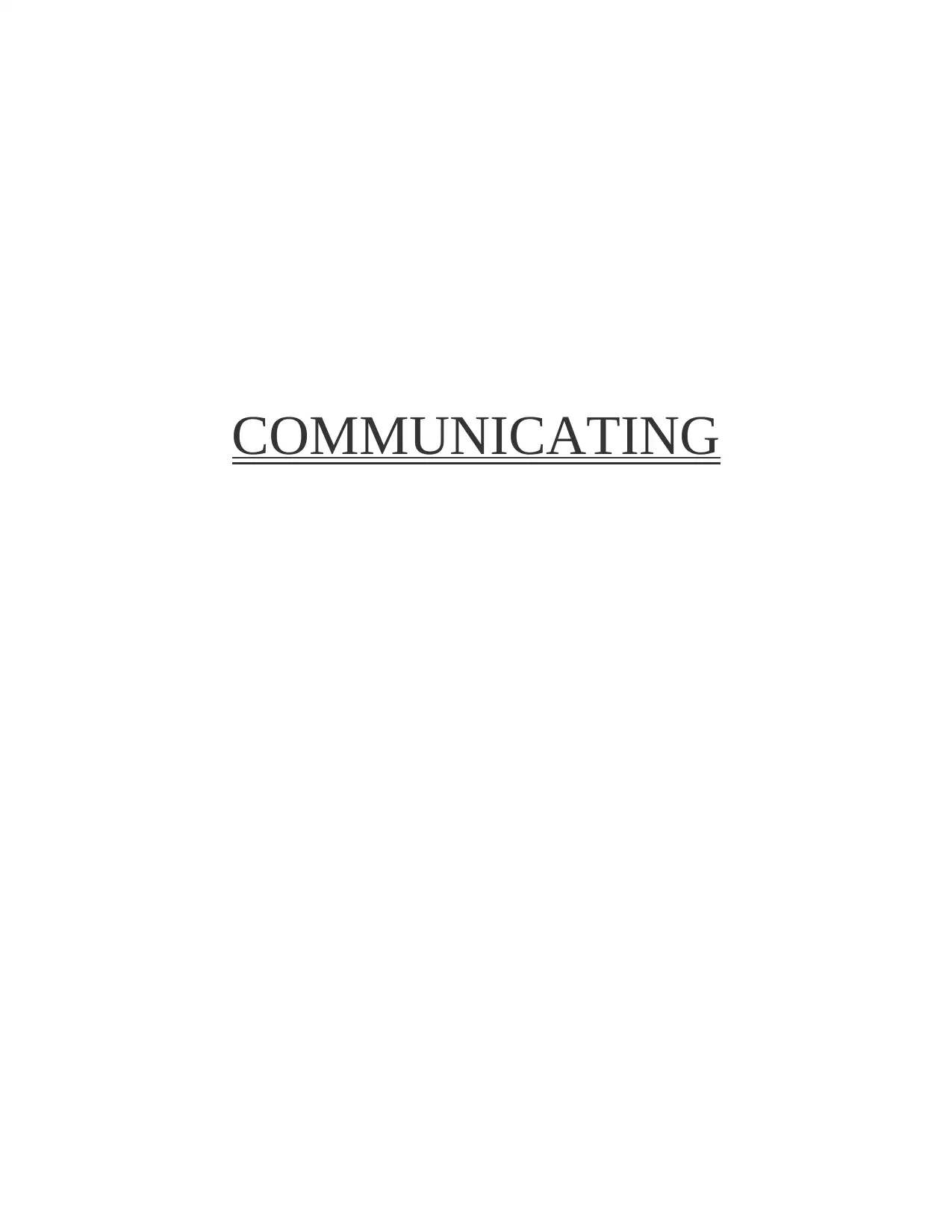
COMMUNICATING
Paraphrase This Document
Need a fresh take? Get an instant paraphrase of this document with our AI Paraphraser
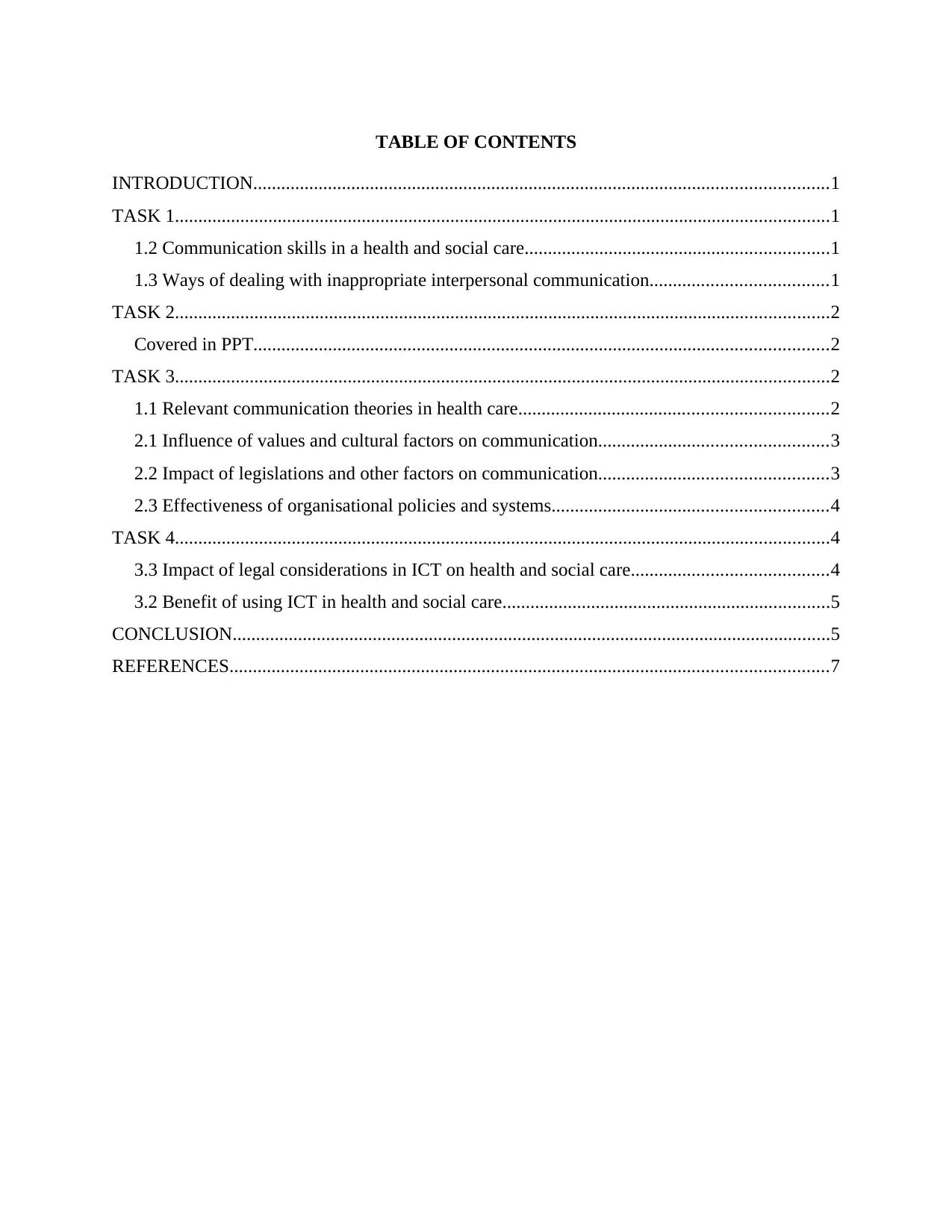
TABLE OF CONTENTS
INTRODUCTION...........................................................................................................................1
TASK 1............................................................................................................................................1
1.2 Communication skills in a health and social care.................................................................1
1.3 Ways of dealing with inappropriate interpersonal communication......................................1
TASK 2............................................................................................................................................2
Covered in PPT...........................................................................................................................2
TASK 3............................................................................................................................................2
1.1 Relevant communication theories in health care..................................................................2
2.1 Influence of values and cultural factors on communication.................................................3
2.2 Impact of legislations and other factors on communication.................................................3
2.3 Effectiveness of organisational policies and systems...........................................................4
TASK 4............................................................................................................................................4
3.3 Impact of legal considerations in ICT on health and social care..........................................4
3.2 Benefit of using ICT in health and social care......................................................................5
CONCLUSION................................................................................................................................5
REFERENCES................................................................................................................................7
INTRODUCTION...........................................................................................................................1
TASK 1............................................................................................................................................1
1.2 Communication skills in a health and social care.................................................................1
1.3 Ways of dealing with inappropriate interpersonal communication......................................1
TASK 2............................................................................................................................................2
Covered in PPT...........................................................................................................................2
TASK 3............................................................................................................................................2
1.1 Relevant communication theories in health care..................................................................2
2.1 Influence of values and cultural factors on communication.................................................3
2.2 Impact of legislations and other factors on communication.................................................3
2.3 Effectiveness of organisational policies and systems...........................................................4
TASK 4............................................................................................................................................4
3.3 Impact of legal considerations in ICT on health and social care..........................................4
3.2 Benefit of using ICT in health and social care......................................................................5
CONCLUSION................................................................................................................................5
REFERENCES................................................................................................................................7
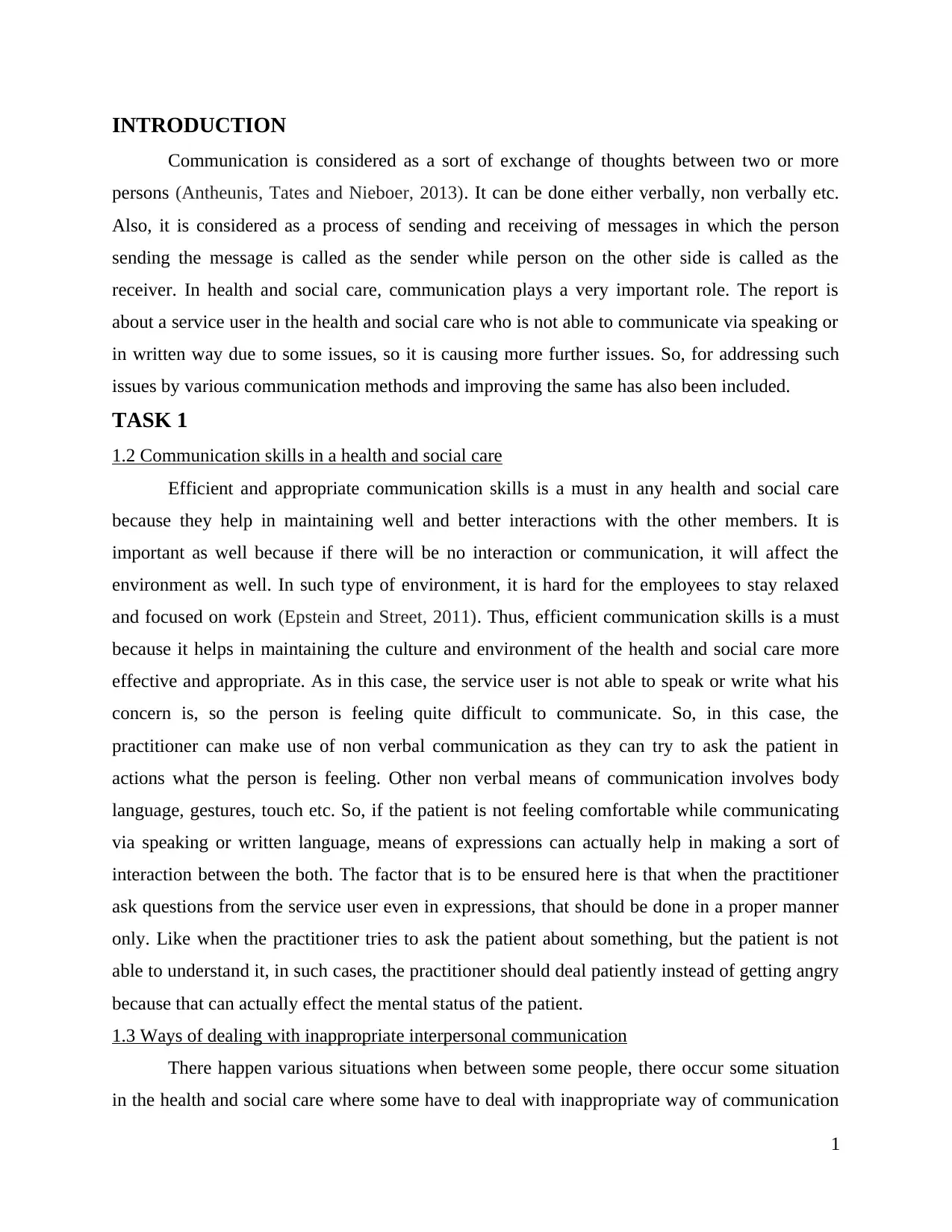
INTRODUCTION
Communication is considered as a sort of exchange of thoughts between two or more
persons (Antheunis, Tates and Nieboer, 2013). It can be done either verbally, non verbally etc.
Also, it is considered as a process of sending and receiving of messages in which the person
sending the message is called as the sender while person on the other side is called as the
receiver. In health and social care, communication plays a very important role. The report is
about a service user in the health and social care who is not able to communicate via speaking or
in written way due to some issues, so it is causing more further issues. So, for addressing such
issues by various communication methods and improving the same has also been included.
TASK 1
1.2 Communication skills in a health and social care
Efficient and appropriate communication skills is a must in any health and social care
because they help in maintaining well and better interactions with the other members. It is
important as well because if there will be no interaction or communication, it will affect the
environment as well. In such type of environment, it is hard for the employees to stay relaxed
and focused on work (Epstein and Street, 2011). Thus, efficient communication skills is a must
because it helps in maintaining the culture and environment of the health and social care more
effective and appropriate. As in this case, the service user is not able to speak or write what his
concern is, so the person is feeling quite difficult to communicate. So, in this case, the
practitioner can make use of non verbal communication as they can try to ask the patient in
actions what the person is feeling. Other non verbal means of communication involves body
language, gestures, touch etc. So, if the patient is not feeling comfortable while communicating
via speaking or written language, means of expressions can actually help in making a sort of
interaction between the both. The factor that is to be ensured here is that when the practitioner
ask questions from the service user even in expressions, that should be done in a proper manner
only. Like when the practitioner tries to ask the patient about something, but the patient is not
able to understand it, in such cases, the practitioner should deal patiently instead of getting angry
because that can actually effect the mental status of the patient.
1.3 Ways of dealing with inappropriate interpersonal communication
There happen various situations when between some people, there occur some situation
in the health and social care where some have to deal with inappropriate way of communication
1
Communication is considered as a sort of exchange of thoughts between two or more
persons (Antheunis, Tates and Nieboer, 2013). It can be done either verbally, non verbally etc.
Also, it is considered as a process of sending and receiving of messages in which the person
sending the message is called as the sender while person on the other side is called as the
receiver. In health and social care, communication plays a very important role. The report is
about a service user in the health and social care who is not able to communicate via speaking or
in written way due to some issues, so it is causing more further issues. So, for addressing such
issues by various communication methods and improving the same has also been included.
TASK 1
1.2 Communication skills in a health and social care
Efficient and appropriate communication skills is a must in any health and social care
because they help in maintaining well and better interactions with the other members. It is
important as well because if there will be no interaction or communication, it will affect the
environment as well. In such type of environment, it is hard for the employees to stay relaxed
and focused on work (Epstein and Street, 2011). Thus, efficient communication skills is a must
because it helps in maintaining the culture and environment of the health and social care more
effective and appropriate. As in this case, the service user is not able to speak or write what his
concern is, so the person is feeling quite difficult to communicate. So, in this case, the
practitioner can make use of non verbal communication as they can try to ask the patient in
actions what the person is feeling. Other non verbal means of communication involves body
language, gestures, touch etc. So, if the patient is not feeling comfortable while communicating
via speaking or written language, means of expressions can actually help in making a sort of
interaction between the both. The factor that is to be ensured here is that when the practitioner
ask questions from the service user even in expressions, that should be done in a proper manner
only. Like when the practitioner tries to ask the patient about something, but the patient is not
able to understand it, in such cases, the practitioner should deal patiently instead of getting angry
because that can actually effect the mental status of the patient.
1.3 Ways of dealing with inappropriate interpersonal communication
There happen various situations when between some people, there occur some situation
in the health and social care where some have to deal with inappropriate way of communication
1
⊘ This is a preview!⊘
Do you want full access?
Subscribe today to unlock all pages.

Trusted by 1+ million students worldwide
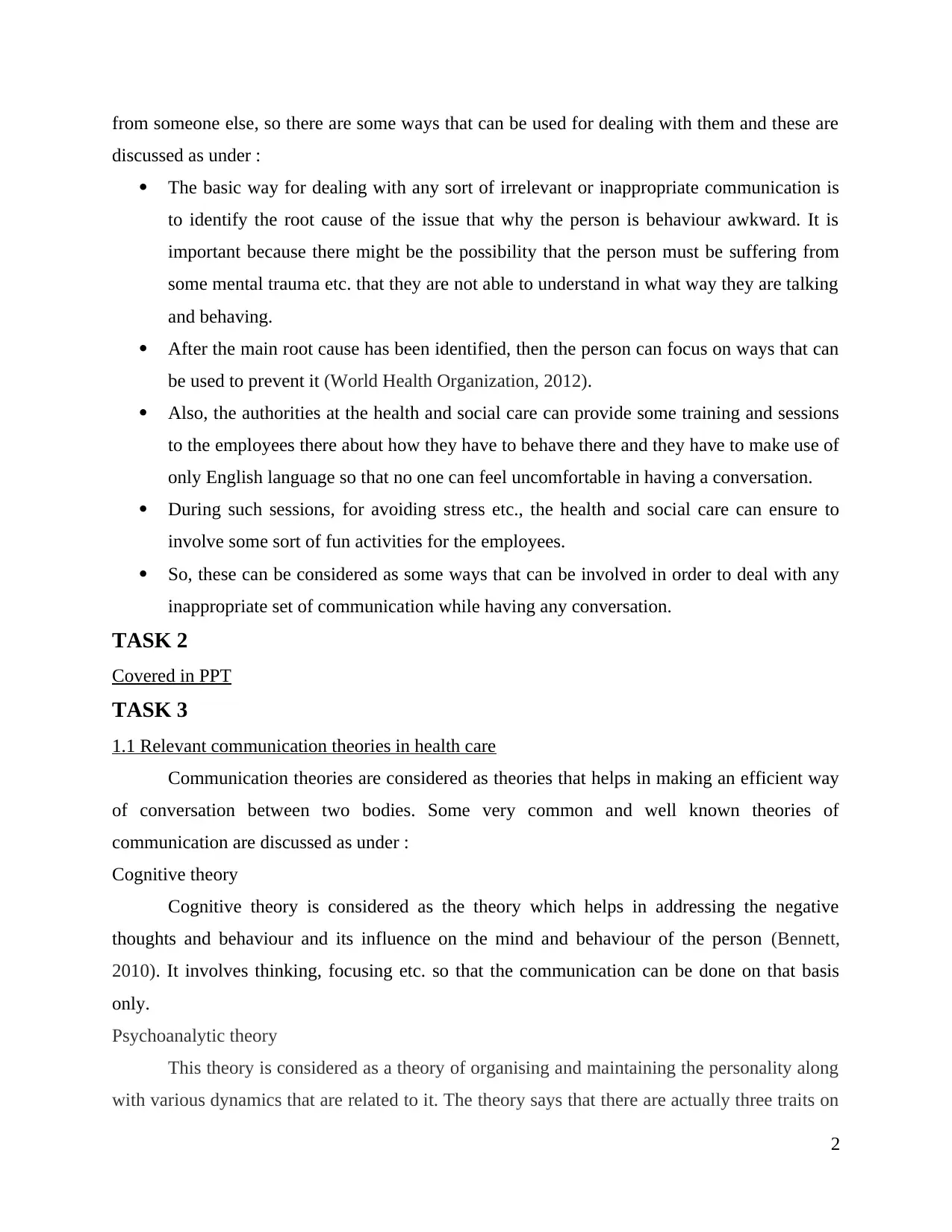
from someone else, so there are some ways that can be used for dealing with them and these are
discussed as under :
The basic way for dealing with any sort of irrelevant or inappropriate communication is
to identify the root cause of the issue that why the person is behaviour awkward. It is
important because there might be the possibility that the person must be suffering from
some mental trauma etc. that they are not able to understand in what way they are talking
and behaving.
After the main root cause has been identified, then the person can focus on ways that can
be used to prevent it (World Health Organization, 2012).
Also, the authorities at the health and social care can provide some training and sessions
to the employees there about how they have to behave there and they have to make use of
only English language so that no one can feel uncomfortable in having a conversation.
During such sessions, for avoiding stress etc., the health and social care can ensure to
involve some sort of fun activities for the employees.
So, these can be considered as some ways that can be involved in order to deal with any
inappropriate set of communication while having any conversation.
TASK 2
Covered in PPT
TASK 3
1.1 Relevant communication theories in health care
Communication theories are considered as theories that helps in making an efficient way
of conversation between two bodies. Some very common and well known theories of
communication are discussed as under :
Cognitive theory
Cognitive theory is considered as the theory which helps in addressing the negative
thoughts and behaviour and its influence on the mind and behaviour of the person (Bennett,
2010). It involves thinking, focusing etc. so that the communication can be done on that basis
only.
Psychoanalytic theory
This theory is considered as a theory of organising and maintaining the personality along
with various dynamics that are related to it. The theory says that there are actually three traits on
2
discussed as under :
The basic way for dealing with any sort of irrelevant or inappropriate communication is
to identify the root cause of the issue that why the person is behaviour awkward. It is
important because there might be the possibility that the person must be suffering from
some mental trauma etc. that they are not able to understand in what way they are talking
and behaving.
After the main root cause has been identified, then the person can focus on ways that can
be used to prevent it (World Health Organization, 2012).
Also, the authorities at the health and social care can provide some training and sessions
to the employees there about how they have to behave there and they have to make use of
only English language so that no one can feel uncomfortable in having a conversation.
During such sessions, for avoiding stress etc., the health and social care can ensure to
involve some sort of fun activities for the employees.
So, these can be considered as some ways that can be involved in order to deal with any
inappropriate set of communication while having any conversation.
TASK 2
Covered in PPT
TASK 3
1.1 Relevant communication theories in health care
Communication theories are considered as theories that helps in making an efficient way
of conversation between two bodies. Some very common and well known theories of
communication are discussed as under :
Cognitive theory
Cognitive theory is considered as the theory which helps in addressing the negative
thoughts and behaviour and its influence on the mind and behaviour of the person (Bennett,
2010). It involves thinking, focusing etc. so that the communication can be done on that basis
only.
Psychoanalytic theory
This theory is considered as a theory of organising and maintaining the personality along
with various dynamics that are related to it. The theory says that there are actually three traits on
2
Paraphrase This Document
Need a fresh take? Get an instant paraphrase of this document with our AI Paraphraser
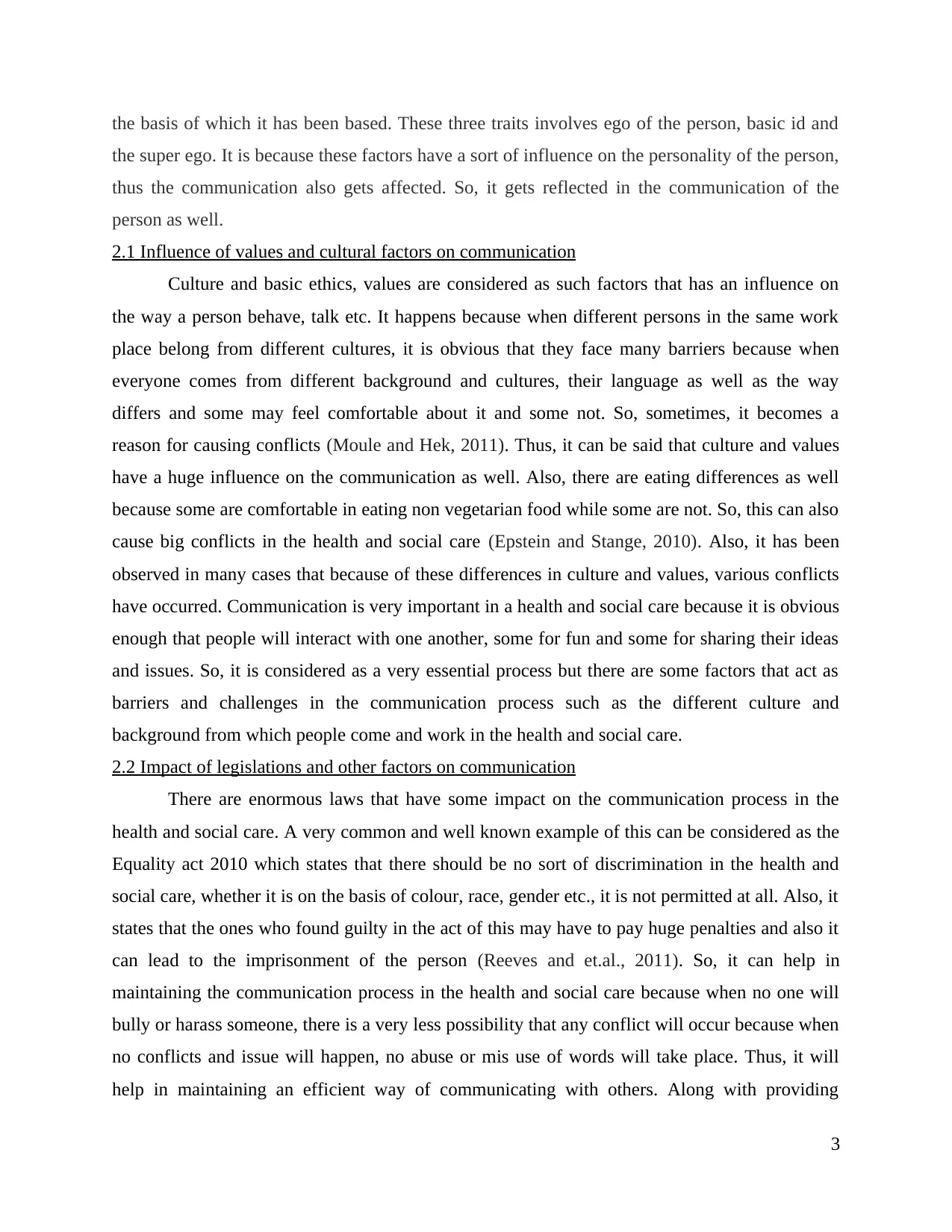
the basis of which it has been based. These three traits involves ego of the person, basic id and
the super ego. It is because these factors have a sort of influence on the personality of the person,
thus the communication also gets affected. So, it gets reflected in the communication of the
person as well.
2.1 Influence of values and cultural factors on communication
Culture and basic ethics, values are considered as such factors that has an influence on
the way a person behave, talk etc. It happens because when different persons in the same work
place belong from different cultures, it is obvious that they face many barriers because when
everyone comes from different background and cultures, their language as well as the way
differs and some may feel comfortable about it and some not. So, sometimes, it becomes a
reason for causing conflicts (Moule and Hek, 2011). Thus, it can be said that culture and values
have a huge influence on the communication as well. Also, there are eating differences as well
because some are comfortable in eating non vegetarian food while some are not. So, this can also
cause big conflicts in the health and social care (Epstein and Stange, 2010). Also, it has been
observed in many cases that because of these differences in culture and values, various conflicts
have occurred. Communication is very important in a health and social care because it is obvious
enough that people will interact with one another, some for fun and some for sharing their ideas
and issues. So, it is considered as a very essential process but there are some factors that act as
barriers and challenges in the communication process such as the different culture and
background from which people come and work in the health and social care.
2.2 Impact of legislations and other factors on communication
There are enormous laws that have some impact on the communication process in the
health and social care. A very common and well known example of this can be considered as the
Equality act 2010 which states that there should be no sort of discrimination in the health and
social care, whether it is on the basis of colour, race, gender etc., it is not permitted at all. Also, it
states that the ones who found guilty in the act of this may have to pay huge penalties and also it
can lead to the imprisonment of the person (Reeves and et.al., 2011). So, it can help in
maintaining the communication process in the health and social care because when no one will
bully or harass someone, there is a very less possibility that any conflict will occur because when
no conflicts and issue will happen, no abuse or mis use of words will take place. Thus, it will
help in maintaining an efficient way of communicating with others. Along with providing
3
the super ego. It is because these factors have a sort of influence on the personality of the person,
thus the communication also gets affected. So, it gets reflected in the communication of the
person as well.
2.1 Influence of values and cultural factors on communication
Culture and basic ethics, values are considered as such factors that has an influence on
the way a person behave, talk etc. It happens because when different persons in the same work
place belong from different cultures, it is obvious that they face many barriers because when
everyone comes from different background and cultures, their language as well as the way
differs and some may feel comfortable about it and some not. So, sometimes, it becomes a
reason for causing conflicts (Moule and Hek, 2011). Thus, it can be said that culture and values
have a huge influence on the communication as well. Also, there are eating differences as well
because some are comfortable in eating non vegetarian food while some are not. So, this can also
cause big conflicts in the health and social care (Epstein and Stange, 2010). Also, it has been
observed in many cases that because of these differences in culture and values, various conflicts
have occurred. Communication is very important in a health and social care because it is obvious
enough that people will interact with one another, some for fun and some for sharing their ideas
and issues. So, it is considered as a very essential process but there are some factors that act as
barriers and challenges in the communication process such as the different culture and
background from which people come and work in the health and social care.
2.2 Impact of legislations and other factors on communication
There are enormous laws that have some impact on the communication process in the
health and social care. A very common and well known example of this can be considered as the
Equality act 2010 which states that there should be no sort of discrimination in the health and
social care, whether it is on the basis of colour, race, gender etc., it is not permitted at all. Also, it
states that the ones who found guilty in the act of this may have to pay huge penalties and also it
can lead to the imprisonment of the person (Reeves and et.al., 2011). So, it can help in
maintaining the communication process in the health and social care because when no one will
bully or harass someone, there is a very less possibility that any conflict will occur because when
no conflicts and issue will happen, no abuse or mis use of words will take place. Thus, it will
help in maintaining an efficient way of communicating with others. Along with providing
3
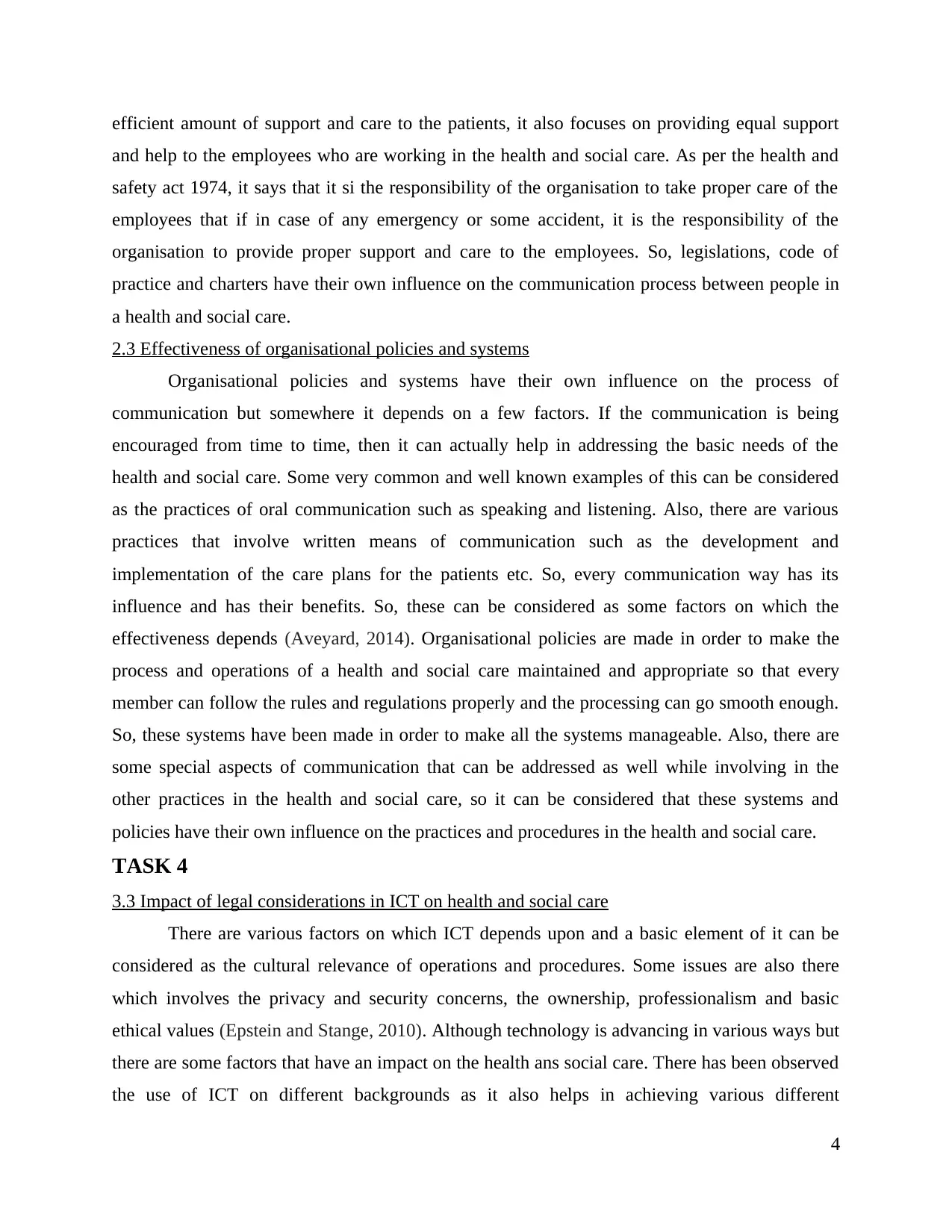
efficient amount of support and care to the patients, it also focuses on providing equal support
and help to the employees who are working in the health and social care. As per the health and
safety act 1974, it says that it si the responsibility of the organisation to take proper care of the
employees that if in case of any emergency or some accident, it is the responsibility of the
organisation to provide proper support and care to the employees. So, legislations, code of
practice and charters have their own influence on the communication process between people in
a health and social care.
2.3 Effectiveness of organisational policies and systems
Organisational policies and systems have their own influence on the process of
communication but somewhere it depends on a few factors. If the communication is being
encouraged from time to time, then it can actually help in addressing the basic needs of the
health and social care. Some very common and well known examples of this can be considered
as the practices of oral communication such as speaking and listening. Also, there are various
practices that involve written means of communication such as the development and
implementation of the care plans for the patients etc. So, every communication way has its
influence and has their benefits. So, these can be considered as some factors on which the
effectiveness depends (Aveyard, 2014). Organisational policies are made in order to make the
process and operations of a health and social care maintained and appropriate so that every
member can follow the rules and regulations properly and the processing can go smooth enough.
So, these systems have been made in order to make all the systems manageable. Also, there are
some special aspects of communication that can be addressed as well while involving in the
other practices in the health and social care, so it can be considered that these systems and
policies have their own influence on the practices and procedures in the health and social care.
TASK 4
3.3 Impact of legal considerations in ICT on health and social care
There are various factors on which ICT depends upon and a basic element of it can be
considered as the cultural relevance of operations and procedures. Some issues are also there
which involves the privacy and security concerns, the ownership, professionalism and basic
ethical values (Epstein and Stange, 2010). Although technology is advancing in various ways but
there are some factors that have an impact on the health ans social care. There has been observed
the use of ICT on different backgrounds as it also helps in achieving various different
4
and help to the employees who are working in the health and social care. As per the health and
safety act 1974, it says that it si the responsibility of the organisation to take proper care of the
employees that if in case of any emergency or some accident, it is the responsibility of the
organisation to provide proper support and care to the employees. So, legislations, code of
practice and charters have their own influence on the communication process between people in
a health and social care.
2.3 Effectiveness of organisational policies and systems
Organisational policies and systems have their own influence on the process of
communication but somewhere it depends on a few factors. If the communication is being
encouraged from time to time, then it can actually help in addressing the basic needs of the
health and social care. Some very common and well known examples of this can be considered
as the practices of oral communication such as speaking and listening. Also, there are various
practices that involve written means of communication such as the development and
implementation of the care plans for the patients etc. So, every communication way has its
influence and has their benefits. So, these can be considered as some factors on which the
effectiveness depends (Aveyard, 2014). Organisational policies are made in order to make the
process and operations of a health and social care maintained and appropriate so that every
member can follow the rules and regulations properly and the processing can go smooth enough.
So, these systems have been made in order to make all the systems manageable. Also, there are
some special aspects of communication that can be addressed as well while involving in the
other practices in the health and social care, so it can be considered that these systems and
policies have their own influence on the practices and procedures in the health and social care.
TASK 4
3.3 Impact of legal considerations in ICT on health and social care
There are various factors on which ICT depends upon and a basic element of it can be
considered as the cultural relevance of operations and procedures. Some issues are also there
which involves the privacy and security concerns, the ownership, professionalism and basic
ethical values (Epstein and Stange, 2010). Although technology is advancing in various ways but
there are some factors that have an impact on the health ans social care. There has been observed
the use of ICT on different backgrounds as it also helps in achieving various different
4
⊘ This is a preview!⊘
Do you want full access?
Subscribe today to unlock all pages.

Trusted by 1+ million students worldwide
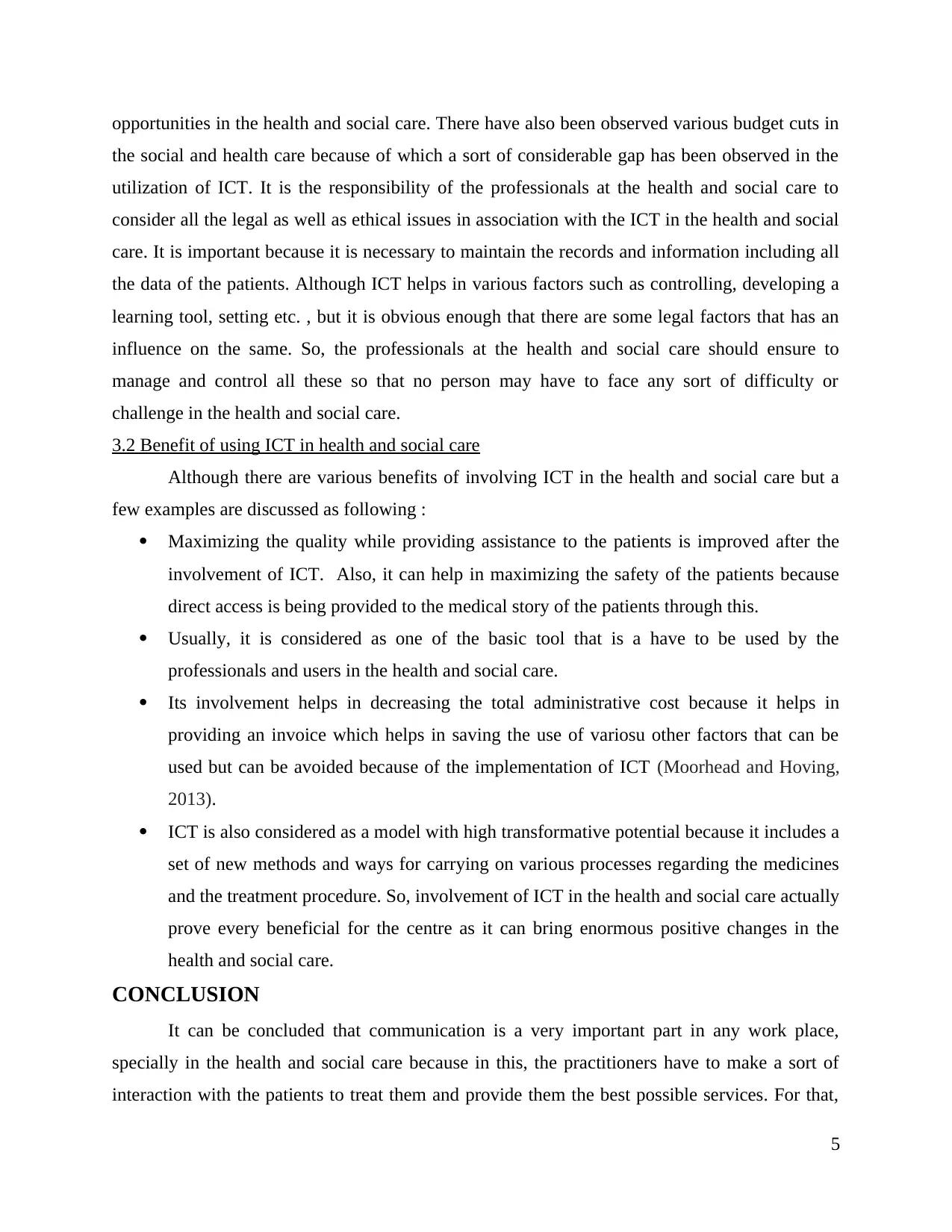
opportunities in the health and social care. There have also been observed various budget cuts in
the social and health care because of which a sort of considerable gap has been observed in the
utilization of ICT. It is the responsibility of the professionals at the health and social care to
consider all the legal as well as ethical issues in association with the ICT in the health and social
care. It is important because it is necessary to maintain the records and information including all
the data of the patients. Although ICT helps in various factors such as controlling, developing a
learning tool, setting etc. , but it is obvious enough that there are some legal factors that has an
influence on the same. So, the professionals at the health and social care should ensure to
manage and control all these so that no person may have to face any sort of difficulty or
challenge in the health and social care.
3.2 Benefit of using ICT in health and social care
Although there are various benefits of involving ICT in the health and social care but a
few examples are discussed as following :
Maximizing the quality while providing assistance to the patients is improved after the
involvement of ICT. Also, it can help in maximizing the safety of the patients because
direct access is being provided to the medical story of the patients through this.
Usually, it is considered as one of the basic tool that is a have to be used by the
professionals and users in the health and social care.
Its involvement helps in decreasing the total administrative cost because it helps in
providing an invoice which helps in saving the use of variosu other factors that can be
used but can be avoided because of the implementation of ICT (Moorhead and Hoving,
2013).
ICT is also considered as a model with high transformative potential because it includes a
set of new methods and ways for carrying on various processes regarding the medicines
and the treatment procedure. So, involvement of ICT in the health and social care actually
prove every beneficial for the centre as it can bring enormous positive changes in the
health and social care.
CONCLUSION
It can be concluded that communication is a very important part in any work place,
specially in the health and social care because in this, the practitioners have to make a sort of
interaction with the patients to treat them and provide them the best possible services. For that,
5
the social and health care because of which a sort of considerable gap has been observed in the
utilization of ICT. It is the responsibility of the professionals at the health and social care to
consider all the legal as well as ethical issues in association with the ICT in the health and social
care. It is important because it is necessary to maintain the records and information including all
the data of the patients. Although ICT helps in various factors such as controlling, developing a
learning tool, setting etc. , but it is obvious enough that there are some legal factors that has an
influence on the same. So, the professionals at the health and social care should ensure to
manage and control all these so that no person may have to face any sort of difficulty or
challenge in the health and social care.
3.2 Benefit of using ICT in health and social care
Although there are various benefits of involving ICT in the health and social care but a
few examples are discussed as following :
Maximizing the quality while providing assistance to the patients is improved after the
involvement of ICT. Also, it can help in maximizing the safety of the patients because
direct access is being provided to the medical story of the patients through this.
Usually, it is considered as one of the basic tool that is a have to be used by the
professionals and users in the health and social care.
Its involvement helps in decreasing the total administrative cost because it helps in
providing an invoice which helps in saving the use of variosu other factors that can be
used but can be avoided because of the implementation of ICT (Moorhead and Hoving,
2013).
ICT is also considered as a model with high transformative potential because it includes a
set of new methods and ways for carrying on various processes regarding the medicines
and the treatment procedure. So, involvement of ICT in the health and social care actually
prove every beneficial for the centre as it can bring enormous positive changes in the
health and social care.
CONCLUSION
It can be concluded that communication is a very important part in any work place,
specially in the health and social care because in this, the practitioners have to make a sort of
interaction with the patients to treat them and provide them the best possible services. For that,
5
Paraphrase This Document
Need a fresh take? Get an instant paraphrase of this document with our AI Paraphraser
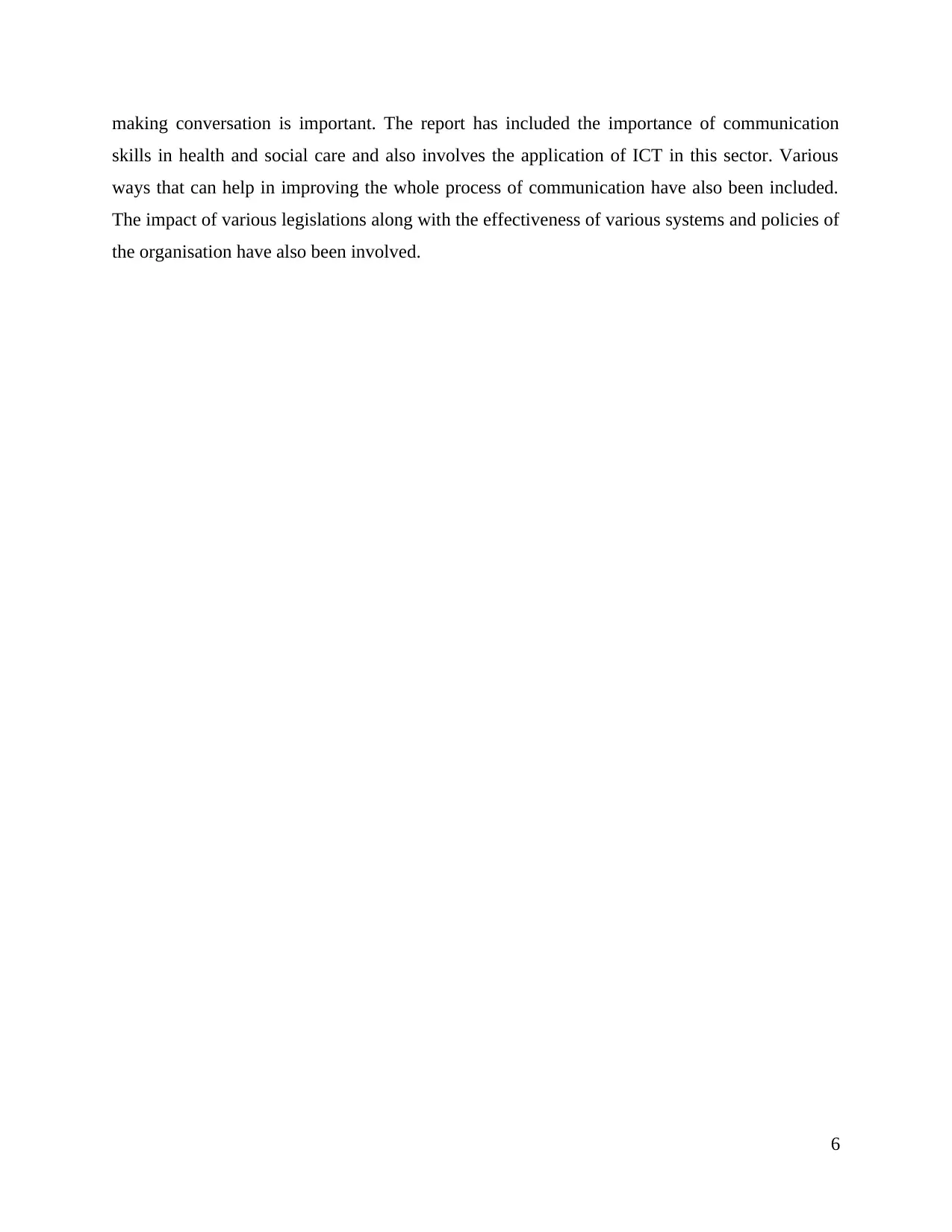
making conversation is important. The report has included the importance of communication
skills in health and social care and also involves the application of ICT in this sector. Various
ways that can help in improving the whole process of communication have also been included.
The impact of various legislations along with the effectiveness of various systems and policies of
the organisation have also been involved.
6
skills in health and social care and also involves the application of ICT in this sector. Various
ways that can help in improving the whole process of communication have also been included.
The impact of various legislations along with the effectiveness of various systems and policies of
the organisation have also been involved.
6
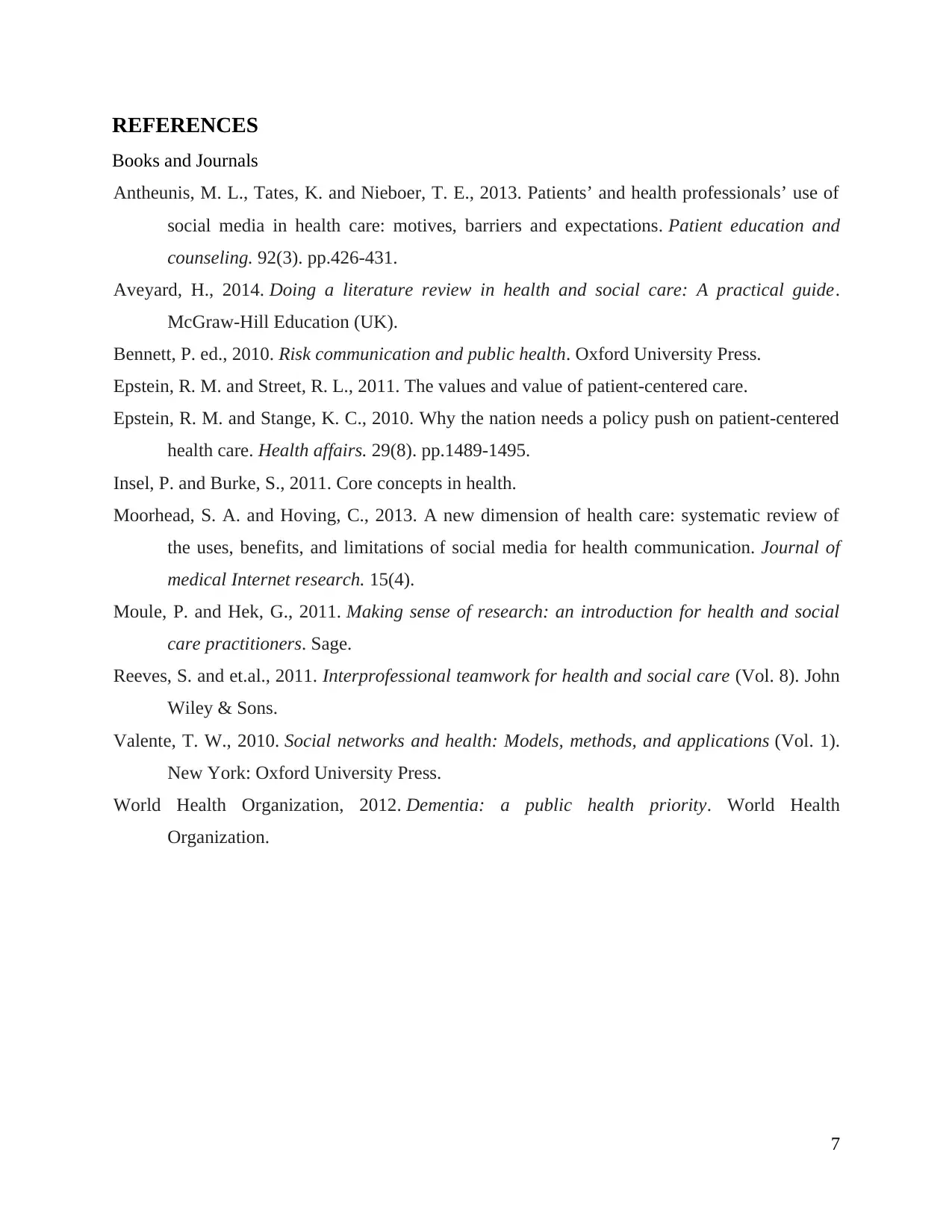
REFERENCES
Books and Journals
Antheunis, M. L., Tates, K. and Nieboer, T. E., 2013. Patients’ and health professionals’ use of
social media in health care: motives, barriers and expectations. Patient education and
counseling. 92(3). pp.426-431.
Aveyard, H., 2014. Doing a literature review in health and social care: A practical guide.
McGraw-Hill Education (UK).
Bennett, P. ed., 2010. Risk communication and public health. Oxford University Press.
Epstein, R. M. and Street, R. L., 2011. The values and value of patient-centered care.
Epstein, R. M. and Stange, K. C., 2010. Why the nation needs a policy push on patient-centered
health care. Health affairs. 29(8). pp.1489-1495.
Insel, P. and Burke, S., 2011. Core concepts in health.
Moorhead, S. A. and Hoving, C., 2013. A new dimension of health care: systematic review of
the uses, benefits, and limitations of social media for health communication. Journal of
medical Internet research. 15(4).
Moule, P. and Hek, G., 2011. Making sense of research: an introduction for health and social
care practitioners. Sage.
Reeves, S. and et.al., 2011. Interprofessional teamwork for health and social care (Vol. 8). John
Wiley & Sons.
Valente, T. W., 2010. Social networks and health: Models, methods, and applications (Vol. 1).
New York: Oxford University Press.
World Health Organization, 2012. Dementia: a public health priority. World Health
Organization.
7
Books and Journals
Antheunis, M. L., Tates, K. and Nieboer, T. E., 2013. Patients’ and health professionals’ use of
social media in health care: motives, barriers and expectations. Patient education and
counseling. 92(3). pp.426-431.
Aveyard, H., 2014. Doing a literature review in health and social care: A practical guide.
McGraw-Hill Education (UK).
Bennett, P. ed., 2010. Risk communication and public health. Oxford University Press.
Epstein, R. M. and Street, R. L., 2011. The values and value of patient-centered care.
Epstein, R. M. and Stange, K. C., 2010. Why the nation needs a policy push on patient-centered
health care. Health affairs. 29(8). pp.1489-1495.
Insel, P. and Burke, S., 2011. Core concepts in health.
Moorhead, S. A. and Hoving, C., 2013. A new dimension of health care: systematic review of
the uses, benefits, and limitations of social media for health communication. Journal of
medical Internet research. 15(4).
Moule, P. and Hek, G., 2011. Making sense of research: an introduction for health and social
care practitioners. Sage.
Reeves, S. and et.al., 2011. Interprofessional teamwork for health and social care (Vol. 8). John
Wiley & Sons.
Valente, T. W., 2010. Social networks and health: Models, methods, and applications (Vol. 1).
New York: Oxford University Press.
World Health Organization, 2012. Dementia: a public health priority. World Health
Organization.
7
⊘ This is a preview!⊘
Do you want full access?
Subscribe today to unlock all pages.

Trusted by 1+ million students worldwide

8
1 out of 10
Related Documents
Your All-in-One AI-Powered Toolkit for Academic Success.
+13062052269
info@desklib.com
Available 24*7 on WhatsApp / Email
![[object Object]](/_next/static/media/star-bottom.7253800d.svg)
Unlock your academic potential
Copyright © 2020–2025 A2Z Services. All Rights Reserved. Developed and managed by ZUCOL.




